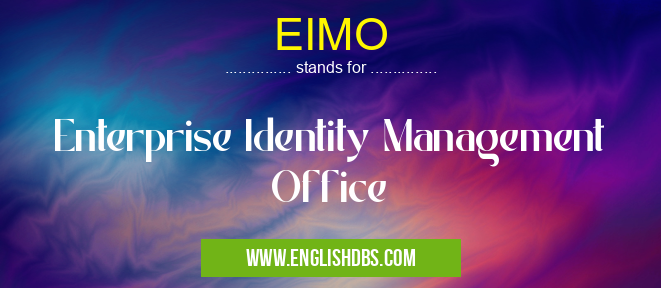What does EIMO mean in MANAGEMENT
EIMO stands for Enterprise Identity Management Office. It is a central organization within an enterprise that is responsible for managing the identities of all users, including employees, contractors, and partners. EIMO is responsible for ensuring that all users have the appropriate access to the resources they need to perform their jobs, while also protecting the enterprise from unauthorized access.

EIMO meaning in Management in Business
EIMO mostly used in an acronym Management in Category Business that means Enterprise Identity Management Office
Shorthand: EIMO,
Full Form: Enterprise Identity Management Office
For more information of "Enterprise Identity Management Office", see the section below.
» Business » Management
Responsibilities of EIMO
- Provisioning and de-provisioning user accounts: EIMO creates and manages user accounts for all employees, contractors, and partners. When an employee joins the company, EIMO creates an account for them and assigns them the appropriate permissions. When an employee leaves the company, EIMO de-provisions their account and removes their access to the company's resources.
- Managing user identities: EIMO maintains a central repository of user identities, which includes information such as the user's name, email address, job title, and department. EIMO also manages user passwords and other authentication credentials.
- Enforcing security policies: EIMO is responsible for enforcing the enterprise's security policies, which govern how users access and use the company's resources. EIMO implements security measures such as multi-factor authentication and access control to protect the enterprise from unauthorized access.
- Providing support to users: EIMO provides support to users who have questions or problems with their user accounts. EIMO can help users reset their passwords, change their permissions, or resolve other account-related issues.
Benefits of EIMO
- Improved security: EIMO helps to improve the security of an enterprise by centralizing the management of user identities and enforcing security policies. This helps to reduce the risk of unauthorized access to the company's resources.
- Increased efficiency: EIMO can help to improve the efficiency of an enterprise by automating the provisioning and de-provisioning of user accounts. This frees up IT staff to focus on other tasks, such as developing new applications and services.
- Enhanced compliance: EIMO can help an enterprise to comply with regulatory requirements, such as the Sarbanes-Oxley Act and the Health Insurance Portability and Accountability Act (HIPAA). EIMO provides a centralized view of all user identities and access rights, which can help an enterprise to demonstrate compliance with these regulations.
Essential Questions and Answers on Enterprise Identity Management Office in "BUSINESS»MANAGEMENT"
What is EIMO?
Enterprise Identity Management Office (EIMO) is a central authority responsible for managing and governing the identities of users within an organization. It ensures secure access to resources and services, streamlines identity-related processes, and enhances compliance with regulations.
What are the key functions of EIMO?
EIMO's functions include user provisioning, access management, identity authentication, directory services, password management, and compliance monitoring. It coordinates with other IT systems and departments to ensure a holistic and secure identity management strategy.
How does EIMO improve security?
EIMO strengthens security by centralizing identity management, implementing multi-factor authentication, enforcing password policies, and monitoring for suspicious activities. It minimizes the risk of unauthorized access, data breaches, and cyber threats by ensuring that only authorized users have access to the appropriate resources.
What are the benefits of EIMO?
EIMO offers numerous benefits, including improved security, streamlined user management, simplified compliance, enhanced user experience, and cost savings. It reduces the administrative burden, automates identity-related tasks, and fosters a more secure and efficient work environment.
How is EIMO implemented?
EIMO implementation involves planning, selecting an appropriate identity management platform, integrating with existing systems, and establishing governance processes. It requires collaboration between IT, HR, and business units to ensure a successful and effective rollout.
What are the challenges of EIMO?
Common challenges include data integration issues, user adoption, compliance requirements, and resource constraints. EIMO implementation and management require careful planning, technical expertise, and ongoing monitoring to overcome these challenges and achieve optimal results.
How can I learn more about EIMO?
There are numerous resources available, including industry reports, whitepapers, online forums, and professional training programs. Consulting with experts in the field can also provide valuable insights and guidance on EIMO implementation and best practices.
Final Words: EIMO is a critical part of any enterprise IT infrastructure. By managing user identities and enforcing security policies, EIMO helps to protect the enterprise from unauthorized access and improves the efficiency of IT operations.
